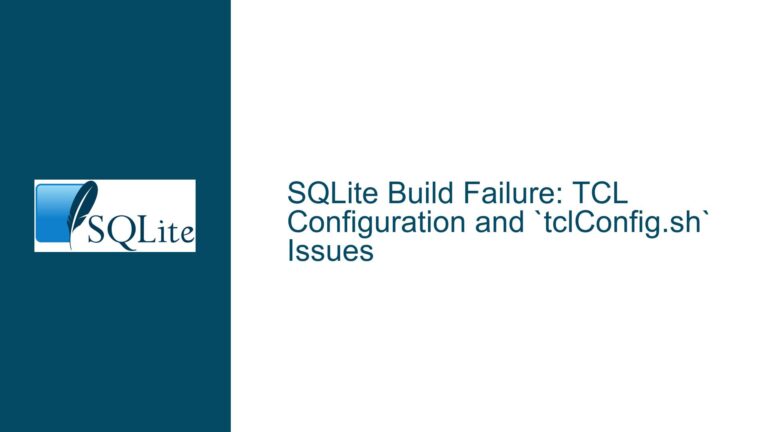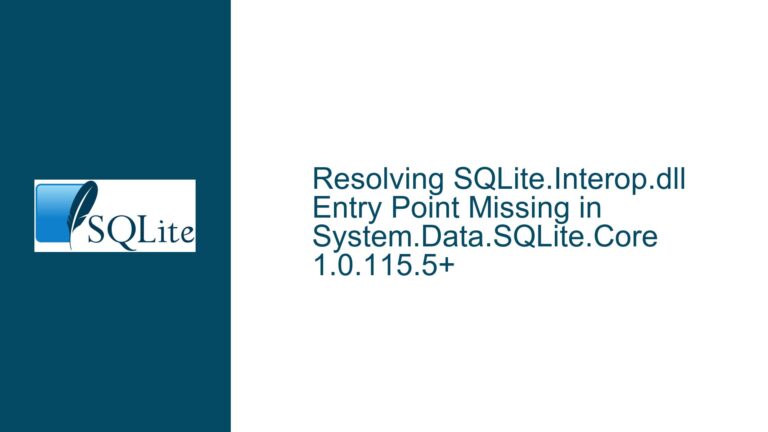Bizarre SQLite Insert Behavior: Data Loss and Threading Issues
Issue Overview: Intermittent Data Loss and Thread-Safe Violations in SQLite Inserts
The core issue revolves around an SQLite database used in a Python-based to-do application, where data insertion exhibits two primary problems: intermittent data loss upon application reload and threading-related errors. The application uses the Flet module for the GUI and SQLite for data storage. The schema consists of two tables: categories and tasks, with a foreign key relationship between them. The categories table stores task categories, while the tasks table stores individual tasks linked to a category.
The data loss issue manifests when rows inserted into the categories table disappear after the application is reloaded. This suggests that the data is not being persistently written to the database file. Additionally, the application throws a threading error: sqlite3.ProgrammingError: SQLite objects created in a thread can only be used in that same thread. The object was created in thread id 37188 and this is thread id 37444. This error indicates that the SQLite connection object is being accessed across multiple threads, which violates SQLite’s thread-safety rules.
The schema design itself is sound, with proper use of foreign keys and data types. However, the issues stem from how the database connection is managed and how data is committed to the database. The intermittent nature of the data loss suggests that the database connection or transaction handling is inconsistent, while the threading error points to improper handling of SQLite objects in a multi-threaded environment.
Possible Causes: Connection Management and Threading Missteps
Inconsistent Database Connection Handling: The database connection is opened and closed within the
add_categoryfunction using a context manager (with sqlite3.connect('data/HITS.db') as conn). While this ensures the connection is closed after use, it does not guarantee that the connection is reused efficiently across function calls. If the connection is not properly committed or if the application crashes before the commit is executed, the data may not be written to the database file.Thread-Safety Violations: SQLite connections and cursors are not thread-safe by default. The error message explicitly states that the SQLite object was created in one thread but accessed in another. This suggests that the application is sharing the same connection or cursor object across multiple threads, which is not allowed. SQLite requires that each thread use its own connection object.
File System Issues: The database file (
data/HITS.db) may not be accessible or writable at all times, especially if the application is running in a multi-threaded or multi-process environment. If the file is locked or inaccessible, the data may not be written persistently.Improper Use of Transactions: The
conn.commit()statement is used to commit changes to the database. However, if an exception occurs before the commit is executed, the changes may be rolled back. The current implementation does not include error handling to ensure that the commit is always executed.Memory Database Misconfiguration: The discussion mentions the use of
:memory:as a database name, which creates an in-memory database that is not persisted to disk. While this is not the case in the provided code, it highlights the importance of ensuring that the database file path is correct and that the database is not inadvertently created in memory.
Troubleshooting Steps, Solutions & Fixes: Ensuring Data Persistence and Thread Safety
Step 1: Verify Database File Path and Permissions
Ensure that the database file path (data/HITS.db) is correct and that the application has write permissions to the directory. Use an absolute path instead of a relative path to avoid issues with the working directory changing between runs. For example:
import os
db_path = os.path.abspath('data/HITS.db')
with sqlite3.connect(db_path) as conn:
# Perform database operations
Step 2: Implement Proper Connection Pooling
Instead of opening and closing the database connection within each function call, use a connection pool or a single shared connection object. This ensures that the connection is reused efficiently and reduces the risk of data loss due to connection issues. For example:
import sqlite3
from contextlib import contextmanager
# Create a connection pool
connection_pool = sqlite3.connect('data/HITS.db', check_same_thread=False)
@contextmanager
def get_db_connection():
try:
yield connection_pool
except sqlite3.Error as e:
print("Database error:", e)
raise
finally:
pass # Do not close the connection here
def add_category(category):
with get_db_connection() as conn:
cursor = conn.cursor()
cursor.execute("INSERT INTO categories(name) VALUES(?)", (category,))
conn.commit()
print(cursor.lastrowid)
Step 3: Ensure Thread-Safe Database Access
Each thread must use its own connection object. If the application is multi-threaded, create a new connection for each thread. Alternatively, use a thread-local storage mechanism to manage connections. For example:
import threading
thread_local = threading.local()
def get_thread_local_connection():
if not hasattr(thread_local, "connection"):
thread_local.connection = sqlite3.connect('data/HITS.db', check_same_thread=False)
return thread_local.connection
def add_category(category):
conn = get_thread_local_connection()
cursor = conn.cursor()
cursor.execute("INSERT INTO categories(name) VALUES(?)", (category,))
conn.commit()
print(cursor.lastrowid)
Step 4: Implement Robust Error Handling and Transaction Management
Wrap database operations in a try-except block to handle exceptions and ensure that transactions are committed or rolled back appropriately. For example:
def add_category(category):
conn = None
try:
conn = sqlite3.connect('data/HITS.db', check_same_thread=False)
cursor = conn.cursor()
cursor.execute("INSERT INTO categories(name) VALUES(?)", (category,))
conn.commit()
print(cursor.lastrowid)
except sqlite3.Error as e:
print("Database error:", e)
if conn:
conn.rollback()
finally:
if conn:
conn.close()
Step 5: Use WAL Mode for Better Concurrency
Enable Write-Ahead Logging (WAL) mode to improve concurrency and reduce the likelihood of database locks. WAL mode allows multiple readers and a single writer to access the database simultaneously. Enable WAL mode as follows:
def enable_wal_mode():
with sqlite3.connect('data/HITS.db') as conn:
cursor = conn.cursor()
cursor.execute("PRAGMA journal_mode=WAL;")
conn.commit()
enable_wal_mode()
Step 6: Validate Data Persistence
After inserting data, immediately query the database to verify that the data has been persisted. This helps identify issues with data loss early. For example:
def add_category(category):
with sqlite3.connect('data/HITS.db') as conn:
cursor = conn.cursor()
cursor.execute("INSERT INTO categories(name) VALUES(?)", (category,))
conn.commit()
last_row_id = cursor.lastrowid
cursor.execute("SELECT * FROM categories WHERE id = ?", (last_row_id,))
result = cursor.fetchone()
if result:
print("Data persisted successfully:", result)
else:
print("Data not found in the database.")
By following these steps, you can address the issues of intermittent data loss and threading violations in your SQLite-based application. Proper connection management, thread safety, and transaction handling are critical to ensuring data integrity and application stability.






